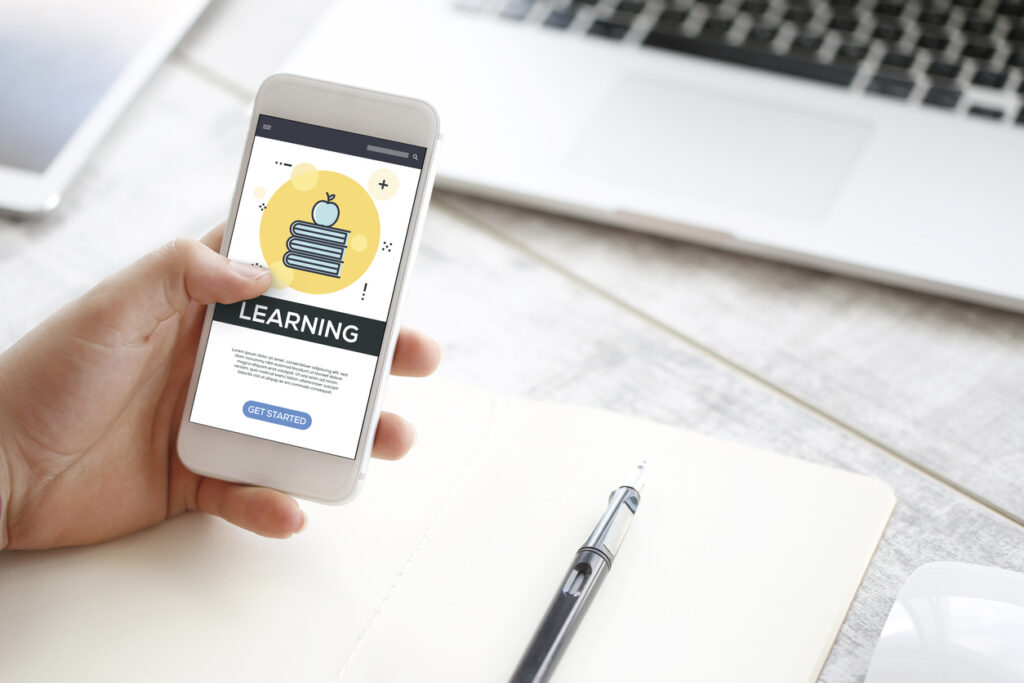Learning professionals have abundant tools, technologies and approaches to help boost individual and organisational performance. To create the most relevant blended solutions, start with the performance challenge and an open mind about how to tackle it.
Despite the term ‘blended learning’ being in use since the late 1990s, people often still disagree about its meaning.
For me, having specialised in blended learning for years, it means choosing delivery methods which engage your learners, complement your learning culture, and suit the subject matter of your learning.
As such, it’s only natural that people disagree about what constitutes the perfect blend: blended learning should mean different things to different people and different organisations as their learners, culture and material can vary wildly.
For instance, learning that takes place in a corporate environment could be very different to learning in the education sector.
What’s more, someone needing to gem up on compliance has very different needs to a learner honing their management skills.
What blended learning is – or isn’t
What everyone – L&D, the business and learners – doesn’t want or need is a prescriptive approach to blended learning; one that says that 60% of learning has to happen face-to-face and 40% online, for example. After all, one of the best things about blended learning is its flexibility.
Another common mistake is confusing blended learning with a ‘classroom sandwich’: a classroom experience topped and tailed with e-learning. The odds of this being the perfect solution are very thin!
Rather, we’ve seen that blended learning involves L&D professionals having an open mind about delivery methods and offering solutions that suit the learner, context and organisation. This must be the overarching aim when designing any blended strategy.
In some senses, a good way to gain a better understanding of blended learning is to consider what it isn’t – or perhaps more accurately, what it shouldn’t be. Donald Clark does just that in this post.
Clark highlights one of the major failings of many attempts at blended learning – namely carrying on with existing formal learning and then throwing in a few extra bits of online learning to ‘follow up’.
Clark calls this ‘blended teaching’. It is certainly not proper, effective blended learning and so does little to benefit the learner, L&D or the business.
Blended learning involves L&D professionals having an open mind about delivery methods
A poll by Jane Hart, founder of the Centre for Learning and Performance Technologies, shows two things: firstly, that blended learning means different things to different people, and secondly, that many L&D practitioners hold an outdated view of it.
Interestingly, 49% of the 750 L&D professionals participating in the poll think blended learning is a training programme containing a mix of face-to-face and e-learning.
Meanwhile, 21% said it is a training activity containing a range of formats and media, 23% said it is a strategic L&D approach to supporting a wide range of learning initiatives and 7% selected whatever the ‘other’ option may mean. Is it that they don’t know? Haven’t thought about it? Don’t care?
At the point of need
L&D professionals cannot just blend legacy training methods or pick newer learning methods (such as MOOCs or the flipped classroom model) and hope that either ‘will do’.
Clark’s post is particularly critical of flipped classrooms, as it excuses L&D following a prescriptive, one-size-fits-all approach, rather than appreciating the adaptive, bespoke nature of blended learning.
This may be beginning to paint a very bleak picture of blended learning, but it can be very effective!
Critically, however, for blended solutions to hit the spot, L&D professionals must take time to explore what blended learning means in the context of their organisation.
The learner is hugely important in all of this. L&D professionals need an exceptional understanding of how people in their organisation learn, including the changing role of technology.
Many learners have taken control of their own learning because technology enables them to do it. They are learning at the point of need, because again, technology is enabling them to.
The current speed of change makes on demand learning a necessity, and L&D needs to keep up and provide or point to on demand solutions.
L&D professionals must take time to explore what blended learning means in the context of their organisation.
Thinking of learners as consumers can really help. What learning format will best suit their needs? Face-to-face learning is still important, but shouldn’t be a default.
Learning is increasingly happening in smaller chunks, at the time, place and pace that suits the learner. Online learning should therefore be a mobile experience to reflect how learners consume information.
Thinking about context
L&D must also keep learner needs at the forefront when devising learning, along with the organisation’s needs and the learning’s context.
At Bray Leino Learning, we think of learning as a performance issue. How will a piece of learning improve a person’s performance? The organisation’s performance?
Look at the performance issue first and don’t simply select the obvious or the easiest solution. Go for the option or options that are really going to improve performance and yield the best results for everyone.
Look at the performance issue first and don’t simply select the obvious or the easiest solution.
The beauty of blended learning is that it offers choice – to L&D, the business and to learners. Those organisations that understand the flexibility of blended learning are really reaping the results.
Recent research by benchmarking organisation Towards Maturity, called ‘In-Focus: Transforming Formal Learning’ highlights several important benefits enjoyed by organisations that blend their learning programmes. For example:
- Of those questioned, 22% said they blend their programmes and are achieving better performance in a number of key areas as a result.
- Those blending learning are achieving four times the improvement in applying learning back into the workplace compared to non-blending organisations.
This supports my belief that good blended learning is key to maximising the performance gains that your people make from their learning.
As L&D professionals, we owe it to our learners to embrace a range of delivery methods. We must then select the method which engages our learners, complements our learning culture, and suits the subject matter being learned.
In this way, blended learning solutions will continue to be as diverse as the performance challenges which we are using them to overcome.
Interested in this topic? Read Busting four blended learning myths.
Learning professionals have abundant tools, technologies and approaches to help boost individual and organisational performance. To create the most relevant blended solutions, start with the performance challenge and an open mind about how to tackle it.
Despite the term ‘blended learning’ being in use since the late 1990s, people often still disagree about its meaning.
For me, having specialised in blended learning for years, it means choosing delivery methods which engage your learners, complement your learning culture, and suit the subject matter of your learning.
As such, it’s only natural that people disagree about what constitutes the perfect blend: blended learning should mean different things to different people and different organisations as their learners, culture and material can vary wildly.
For instance, learning that takes place in a corporate environment could be very different to learning in the education sector.
What’s more, someone needing to gem up on compliance has very different needs to a learner honing their management skills.
What blended learning is - or isn't
What everyone - L&D, the business and learners - doesn’t want or need is a prescriptive approach to blended learning; one that says that 60% of learning has to happen face-to-face and 40% online, for example. After all, one of the best things about blended learning is its flexibility.
Another common mistake is confusing blended learning with a ‘classroom sandwich’: a classroom experience topped and tailed with e-learning. The odds of this being the perfect solution are very thin!
Rather, we’ve seen that blended learning involves L&D professionals having an open mind about delivery methods and offering solutions that suit the learner, context and organisation. This must be the overarching aim when designing any blended strategy.
In some senses, a good way to gain a better understanding of blended learning is to consider what it isn’t - or perhaps more accurately, what it shouldn’t be. Donald Clark does just that in this post.
Clark highlights one of the major failings of many attempts at blended learning - namely carrying on with existing formal learning and then throwing in a few extra bits of online learning to ‘follow up’.
Clark calls this 'blended teaching'. It is certainly not proper, effective blended learning and so does little to benefit the learner, L&D or the business.
Blended learning involves L&D professionals having an open mind about delivery methods
A poll by Jane Hart, founder of the Centre for Learning and Performance Technologies, shows two things: firstly, that blended learning means different things to different people, and secondly, that many L&D practitioners hold an outdated view of it.
Interestingly, 49% of the 750 L&D professionals participating in the poll think blended learning is a training programme containing a mix of face-to-face and e-learning.
Meanwhile, 21% said it is a training activity containing a range of formats and media, 23% said it is a strategic L&D approach to supporting a wide range of learning initiatives and 7% selected whatever the ‘other’ option may mean. Is it that they don’t know? Haven’t thought about it? Don’t care?
At the point of need
L&D professionals cannot just blend legacy training methods or pick newer learning methods (such as MOOCs or the flipped classroom model) and hope that either ‘will do’.
Clark’s post is particularly critical of flipped classrooms, as it excuses L&D following a prescriptive, one-size-fits-all approach, rather than appreciating the adaptive, bespoke nature of blended learning.
This may be beginning to paint a very bleak picture of blended learning, but it can be very effective!
Critically, however, for blended solutions to hit the spot, L&D professionals must take time to explore what blended learning means in the context of their organisation.
The learner is hugely important in all of this. L&D professionals need an exceptional understanding of how people in their organisation learn, including the changing role of technology.
Many learners have taken control of their own learning because technology enables them to do it. They are learning at the point of need, because again, technology is enabling them to.
The current speed of change makes on demand learning a necessity, and L&D needs to keep up and provide or point to on demand solutions.
L&D professionals must take time to explore what blended learning means in the context of their organisation.
Thinking of learners as consumers can really help. What learning format will best suit their needs? Face-to-face learning is still important, but shouldn’t be a default.
Learning is increasingly happening in smaller chunks, at the time, place and pace that suits the learner. Online learning should therefore be a mobile experience to reflect how learners consume information.
Thinking about context
L&D must also keep learner needs at the forefront when devising learning, along with the organisation’s needs and the learning’s context.
At Bray Leino Learning, we think of learning as a performance issue. How will a piece of learning improve a person’s performance? The organisation’s performance?
Look at the performance issue first and don’t simply select the obvious or the easiest solution. Go for the option or options that are really going to improve performance and yield the best results for everyone.
Look at the performance issue first and don’t simply select the obvious or the easiest solution.
The beauty of blended learning is that it offers choice – to L&D, the business and to learners. Those organisations that understand the flexibility of blended learning are really reaping the results.
Recent research by benchmarking organisation Towards Maturity, called ‘In-Focus: Transforming Formal Learning’ highlights several important benefits enjoyed by organisations that blend their learning programmes. For example:
- Of those questioned, 22% said they blend their programmes and are achieving better performance in a number of key areas as a result.
- Those blending learning are achieving four times the improvement in applying learning back into the workplace compared to non-blending organisations.
This supports my belief that good blended learning is key to maximising the performance gains that your people make from their learning.
As L&D professionals, we owe it to our learners to embrace a range of delivery methods. We must then select the method which engages our learners, complements our learning culture, and suits the subject matter being learned.
In this way, blended learning solutions will continue to be as diverse as the performance challenges which we are using them to overcome.
Interested in this topic? Read Busting four blended learning myths.





